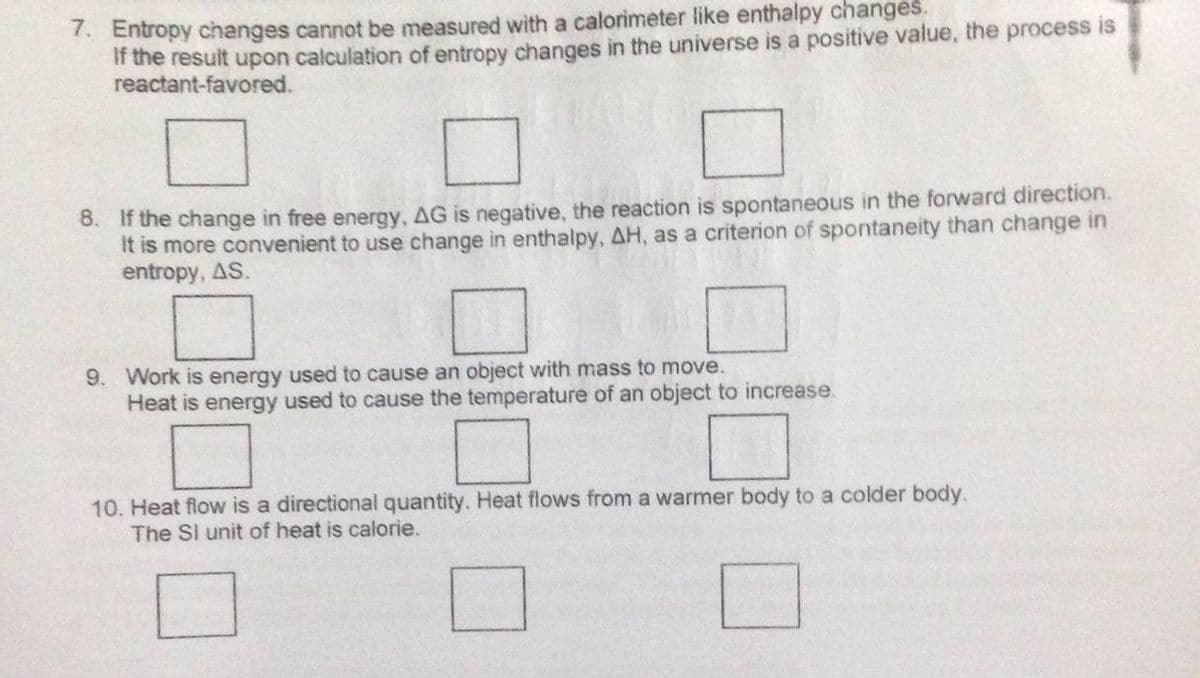Entropy changes cannot be measured with a calorimeter likê enth If the result upon calculation of entropy changes in the universe is a positive value, the process is reactant-favored. If the change in free energy, AG is negative, the reaction is spontaneous in the forward direction. It is more convenient to use change in enthalpy, AH, as a criterion of spontaneity than change in entropy, AS. Work is energy used to cause an object with mass to move. Heat is energy used to cause the temperature of an object to increase.
Entropy changes cannot be measured with a calorimeter likê enth If the result upon calculation of entropy changes in the universe is a positive value, the process is reactant-favored. If the change in free energy, AG is negative, the reaction is spontaneous in the forward direction. It is more convenient to use change in enthalpy, AH, as a criterion of spontaneity than change in entropy, AS. Work is energy used to cause an object with mass to move. Heat is energy used to cause the temperature of an object to increase.
Chemistry for Engineering Students
4th Edition
ISBN:9781337398909
Author:Lawrence S. Brown, Tom Holme
Publisher:Lawrence S. Brown, Tom Holme
Chapter10: Entropy And The Second Law Of Thermodynamics
Section: Chapter Questions
Problem 10.50PAE: For the reaction NO(g)+NO2(g)N2O3(g) , use tabulated thermodynamic data to calculate H and S. Then...
Related questions
Question
MODIFIED TRUE or FALSE
Write the letter T or F inside each box deciding which statement is true or false. Then on the 3rd box, write the letter of your choice based on the given instructions.
A if both statements are true
B if the 1st statement is false and the 2nd statement is true
C if the 1st statement is true and the second statement is false
D if both statements are false

Transcribed Image Text:7. Entropy changes cannot be measured with a calorimeter like enthalpy changes.
If the result upon calculation of entropy changes in the universe is a positive value, the process is
reactant-favored.
8. If the change in free energy, AG is negative, the reaction is spontaneous in the forward direction.
It is more convenient to use change in enthalpy, AH, as a criterion of sporntaneity than change in
entropy, AS.
9. Work is energy used to cause an object with mass to move.
Heat is energy used to cause the temperature of an object to increase.
10. Heat flow is a directional quantity. Heat flows from a warmer body to a colder body.
The Si unit of heat is calorie.
Expert Solution
This question has been solved!
Explore an expertly crafted, step-by-step solution for a thorough understanding of key concepts.
Step by step
Solved in 4 steps with 4 images

Knowledge Booster
Learn more about
Need a deep-dive on the concept behind this application? Look no further. Learn more about this topic, chemistry and related others by exploring similar questions and additional content below.Recommended textbooks for you

Chemistry for Engineering Students
Chemistry
ISBN:
9781337398909
Author:
Lawrence S. Brown, Tom Holme
Publisher:
Cengage Learning

Chemistry: The Molecular Science
Chemistry
ISBN:
9781285199047
Author:
John W. Moore, Conrad L. Stanitski
Publisher:
Cengage Learning

Principles of Modern Chemistry
Chemistry
ISBN:
9781305079113
Author:
David W. Oxtoby, H. Pat Gillis, Laurie J. Butler
Publisher:
Cengage Learning

Chemistry for Engineering Students
Chemistry
ISBN:
9781337398909
Author:
Lawrence S. Brown, Tom Holme
Publisher:
Cengage Learning

Chemistry: The Molecular Science
Chemistry
ISBN:
9781285199047
Author:
John W. Moore, Conrad L. Stanitski
Publisher:
Cengage Learning

Principles of Modern Chemistry
Chemistry
ISBN:
9781305079113
Author:
David W. Oxtoby, H. Pat Gillis, Laurie J. Butler
Publisher:
Cengage Learning

General Chemistry - Standalone book (MindTap Cour…
Chemistry
ISBN:
9781305580343
Author:
Steven D. Gammon, Ebbing, Darrell Ebbing, Steven D., Darrell; Gammon, Darrell Ebbing; Steven D. Gammon, Darrell D.; Gammon, Ebbing; Steven D. Gammon; Darrell
Publisher:
Cengage Learning


Chemistry: An Atoms First Approach
Chemistry
ISBN:
9781305079243
Author:
Steven S. Zumdahl, Susan A. Zumdahl
Publisher:
Cengage Learning